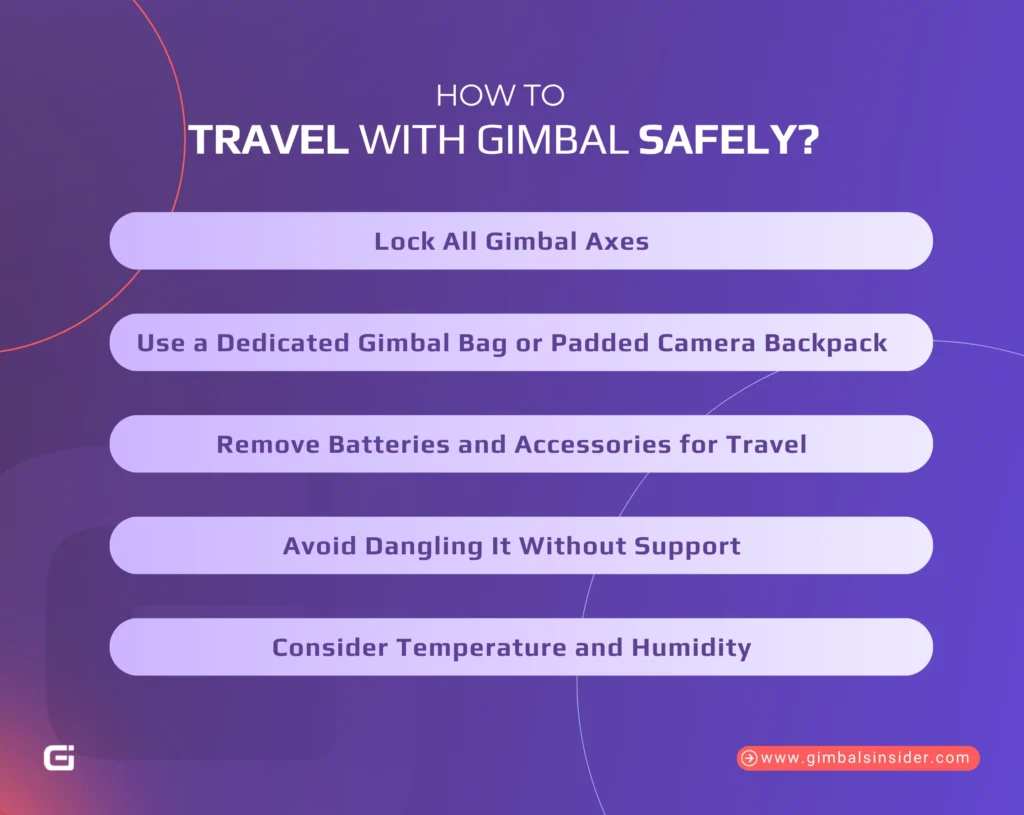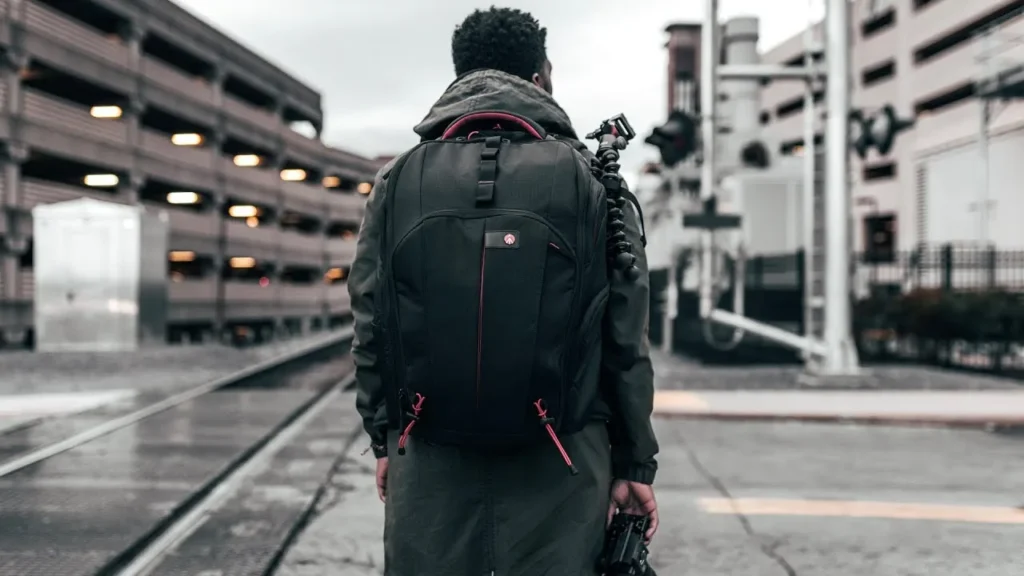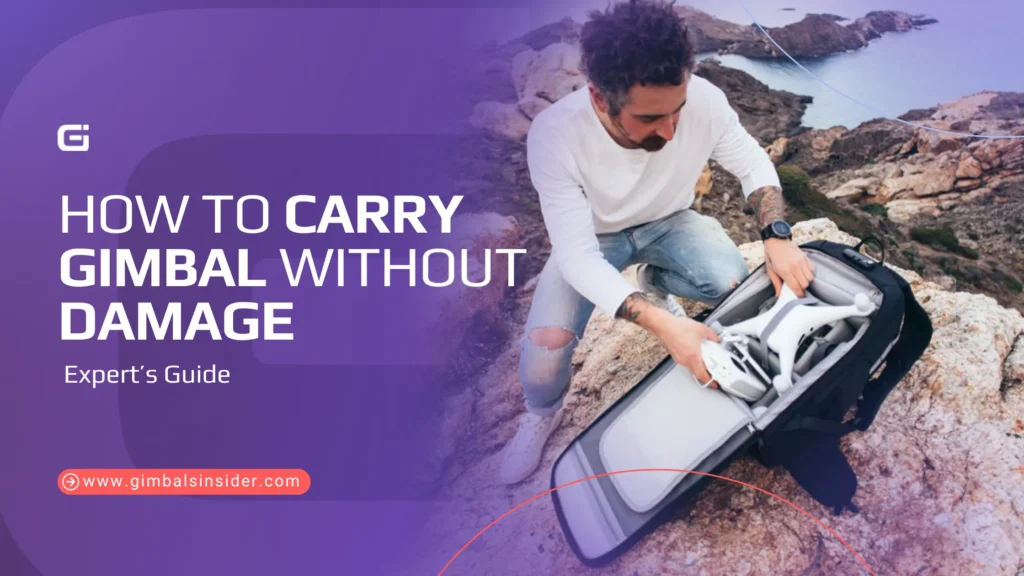Table of Contents
- Top Insights
- How to Travel with Gimbal Safely?
- Lock All Gimbal Axes
- Use a Dedicated Gimbal Bag or Padded Camera Backpack
- Remove Batteries and Accessories for Travel
- Avoid Dangling It Without Support
- Consider Temperature and Humidity
- How to Transport Gimbal in Different Scenarios
- 1. Carry Gimbal While Filming or On Short Walks
- Keep It Close and Supported
- Use Straps to Save Your Arms
- Holsters or Belt Clips
- 2. Carry Gimbal During Travel
- Pack It Like It’s Fragile
- Hard Cases for Real Travel
- The Seatbelt Trick for Car Rides
- Common Mistakes to Avoid When Carrying a Gimbal
- Carrying it Unlocked or Powered On
- Leaving It Loose In a Backpack Without Padding
- Exposing It to Extreme Temperatures or Moisture
- Traveling with Batteries Installed
- Best Gimbal Bags and Cases for Every Situation
- Soft Cases and Camera Backpacks
- Hard Cases for Maximum Protection
- DIY and Budget Options
- Final Words
- FAQs
- 1. Can I carry a gimbal with the camera attached?
- 3. What’s the best way to transport a gimbal on a motorcycle?
- 3. Can I bring my gimbal on an airplane?
My first gimbal didn’t last three months. Not because it was faulty, but because I carried it wrong. So, if you don’t want to face that costly mistake, you must know how to carry gimbal correctly.
To carry a gimbal safely, lock its motors, detach batteries and accessories, and store it in a padded backpack or hard case. Also, keep weight close to your body, use straps or clips for breaks, and protect from extreme heat, cold, or damp.
Moreover, I’ll walk you through —
- Detailed steps for carrying gimbal safely
- Transporting gimbal in different environments
- Major and common mistakes to avoid when carrying
Top Insights
- Always lock all gimbal axes and power it off before transport. It prevents motor strain, misalignment, and accidental power-on.
- Use a padded camera backpack for short trips, and a hard case with custom foam for air or long-distance travel. Keep batteries removed and accessories detached.
- Use straps, holsters, or belt clips to take weight off your arms when walking. Avoid extreme heat, cold, or moisture.
How to Travel with Gimbal Safely?
Lock all axes, remove batteries and accessories, and pack the gimbal in a padded bag or hard case. Along with that, use straps for comfort, avoid dangling, and protect from heat, cold, and humidity.
Here’s a quick breakdown to transport your gimbal without damage.

Lock All Gimbal Axes
Before anything else, lock every motor on your gimbal. These internal components are delicate. So, if they swing freely during transit, even in a soft bag, they can wear down or misalign over time.
A Reddit user, SubjectC, shared, “I just lock the gimbal and lay it on top of my case in my van… Been doing that for years without issue.”
Now, if you skip this step, expect cable tension, broken plugs, or longer setup time on-site. And please, don’t trust foam or luck. Use the locks. Most modern gimbals have axis locks built in.
So, engage them all, then pack.
Use a Dedicated Gimbal Bag or Padded Camera Backpack
Don’t put your gimbal into a general-purpose backpack and pray it doesn’t twist. Gimbals are designed to be awkwardly shaped and lack custom compartments.
That’s why, invest in a bag for a gimbal and camera with adjustable dividers or go for a hard case with custom foam. If you have a budget, you can go for the Manfrotto Flexloader or the Gomatic Peter McKinnon bag.
Remove Batteries and Accessories for Travel
Leaving batteries in while traveling is risky. A bump could power the gimbal on by accident, or worse, cause a short. The same applies to mounted accessories, such as cables and focus motors. In fact, they’re the first to break if the bag takes a hit.
So, unplug, detach, and protect.
One creator, u/lombardo2022, shared the pain. That is “Got to the next site and all the cables had snapped at the plug… Now I pack everything down properly.”
Avoid Dangling It Without Support
Carrying a gimbal by hand without support might seem easy for a minute. However, it quickly leads to motor wear and arm fatigue.
So, use a wrist or neck strap to keep the weight close to your center of gravity. If you need a break between shots, holster it using a belt clip or lay it flat in a padded area. And if you’re wondering about flexibility, you might also ask yourself, Can You Use Gimbal Without App—since knowing this can affect how you handle and carry it during longer shoots.
Consider Temperature and Humidity
Gimbals and extreme temperatures don’t match. So, never leave yours in a hot car or a freezing trunk. If you’re in a humid area, drop silica gel packs in the case to keep the electronics dry and prevent corrosion.
How to Transport Gimbal in Different Scenarios
Here’s how to carry gimbal in real-life scenarios with practical tips from my experience.
1. Carry Gimbal While Filming or On Short Walks
In case you’re filming or just on a short walk with your gimbal and taking random shots, you should carry in the following ways —
Keep It Close and Supported
When you’re walking with a gimbal, hug it in toward your chest or stomach. This takes the weight off your arms and helps keep the shot steady. Hold it out too far, and you’ll feel the muscle burn fast.
Use Straps to Save Your Arms
A wrist strap or neck strap shifts the weight to your shoulder or torso. It’s a simple move that can save your biceps, especially during long takes or run-and-gun shoots.
I often clip mine near the handle so I can quickly switch hands or adjust my shot.
Holsters or Belt Clips
When you’re switching to your still camera or need a quick break, a belt clip or holster lets you “dock” the gimbal safely. Some shooters even use carabiners or DIY hooks to keep the stabilizer off the ground but within reach.
2. Carry Gimbal During Travel
If you’re on the road travelling long distances, here’s how to carry gimbal for backpack so that it remains safe.
Pack It Like It’s Fragile
If you’re just moving around town or on short trips, use a padded camera backpack with adjustable dividers. Also, keep the gimbal in the center of the bag to balance the weight and protect it from knocks.
Hard Cases for Real Travel
For air travel or rough drives, a hard case with custom foam is worth its weight in gold. It keeps the gimbal locked in place, protects the motors from impact, and prevents the arms from shifting. Most of the time, you can just wrap sensitive parts in microfiber cloths for extra padding.
That being said, before you hit the air, you should know whether you can carry a gimbal in flight or not.
The Seatbelt Trick for Car Rides
If you’re on the road between shoots, simply strap the gimbal or its case into the passenger seat. It won’t slide, won’t bounce, and it’ll save you from watching your gear tumble during a sudden stop.
This simple trick comes straight from wedding and festival videographers who are always on the move.
Common Mistakes to Avoid When Carrying a Gimbal
A few careless habits can damage the motors of your gimbal, drain batteries, or throw it out of balance. Here’s what not to do.
Carrying it Unlocked or Powered On
Always lock all axes and switch the gimbal off before moving. If you leave it unlocked, the motors can swing freely, putting strain on bearings and throwing off calibration. On top of that, a powered-on gimbal inside a bag is worse as it risks overheating and can even damage the electronics.
Leaving It Loose In a Backpack Without Padding
If you put your gimbal in a bag without protection, it can hit lenses, batteries, and other equipment. Even small jolts could bend parts or break motors. To avoid this, cushion it with foam, dividers, or a soft wrap.
Plus, if your backpack isn’t made for camera gear, add extra padding to stop things from moving around while you walk.
Exposing It to Extreme Temperatures or Moisture
Cold can stiffen motor grease, heat can swell batteries, and moisture can corrode the electronics. Thus, never leave your gimbal in a hot car, under direct sun, or in damp environments.
If you’re moving from cold to warm, let it adjust to room temperature before powering on. In that case, silica gel packs inside the case help keep moisture at bay.
Traveling with Batteries Installed
Remove batteries before packing, especially for long trips. Installed batteries can power on the gimbal by accident, drain charge, or short out in transit.
Also, store spares in a fireproof pouch or hard-shell battery case, and keep them in your carry-on if flying. It prevents both safety hazards and unwanted surprises on location. And when you’re ready to shoot again, make sure you understand different features—like FPV mode in gimbal
—so you can maximize performance while keeping your setup safe and reliable.
Best Gimbal Bags and Cases for Every Situation
Your gimbal is only as safe as the bag you put it in. So, here’s how you can match the case to save yourself from repairs, rebalances, and whatnot.

Soft Cases and Camera Backpacks
If you’re moving between locations on the same day, you don’t need to overcomplicate it. A good soft case or a padded camera backpack will keep your gimbal safe, close, and ready. They’re light, they ride well on your back, and you can get to your gear fast without unpacking your life.
Go for one with adjustable dividers so the gimbal isn’t sliding around next to your lenses. Weather-resistant fabric and proper padding will save you from dust, drizzle, and the occasional knock on a crowded bus.
Hard Cases for Maximum Protection
If the trip’s going to be rough, you want a hard case. The shell takes the hit, so your motors don’t have to.
The ones worth buying have:
- Waterproof seals so rain or a spilled coffee doesn’t ruin your day.
- Custom-cut foam so the gimbal sits locked and still.
- Shock-absorbing padding that eats the impact from drops and knocks.
I’ve used Pelican and Nanuk with zero regrets, but anything with solid latches and an IP-rated seal will do the job.
DIY and Budget Options
Sometimes you can’t find the perfect fit, or you don’t want to spend big. I’ve made it work with drone backpacks for smaller rigs, and once even carved foam to fit inside an IKEA tote for a snug, safe ride.
For quick, low-risk hops, you can lock the gimbal’s arms with Velcro straps, wrap it in something padded, and toss it in a backpack. I’ve even used a hoodie in a pinch.
It’s not bulletproof, but it’ll get you and your gear to the next spot in one piece.
Final Words
How to carry a gimbal safely comes down to three basics — lock all axes, remove batteries and extras, and pack it in a padded or hard case. Also, keep it close and supported on short walks, and secure it with straps or seatbelts when traveling.
Most importantly, avoid heat, cold, and moisture at all costs. The right bag, whether a weatherproof backpack or a shockproof case, will save you repairs and rebalancing time. As gear evolves, expect more bags designed for ready-to-shoot setups.
Read Our Latest Article:
FAQs
1. Can I carry a gimbal with the camera attached?
Yes, but you must keep it secure by locking all axes to stop movement, using a padded bag to hold it steady, and pulling the battery to avoid surprise power-ups. For long hauls or tight spaces, detach the camera to ease strain and protect the gear.
3. What’s the best way to transport a gimbal on a motorcycle?
For long rides, use a foam-lined hard case strapped tightly and sealed against rain or dust. Short trips can work with a snug backpack. Always remove the camera and battery to cut weight and prevent wear.
3. Can I bring my gimbal on an airplane?
Yes. You can bring a gimbal on a plane, but keep it in carry-on to protect its motors. Remove lithium-ion batteries, lock all axes, and use a padded or hard case. TSA may ask you to take it out for scanning, so pack it for quick access.



Leave A Reply
Comment submitted successfully!